Apples are ready for picking, and pumpkins are ripening on the vine – it’s autumn! With all those gorgeous fall colors in the trees and in our flower beds, it’s the perfect time to liven up our porches and patios with autumn containers gardens too!
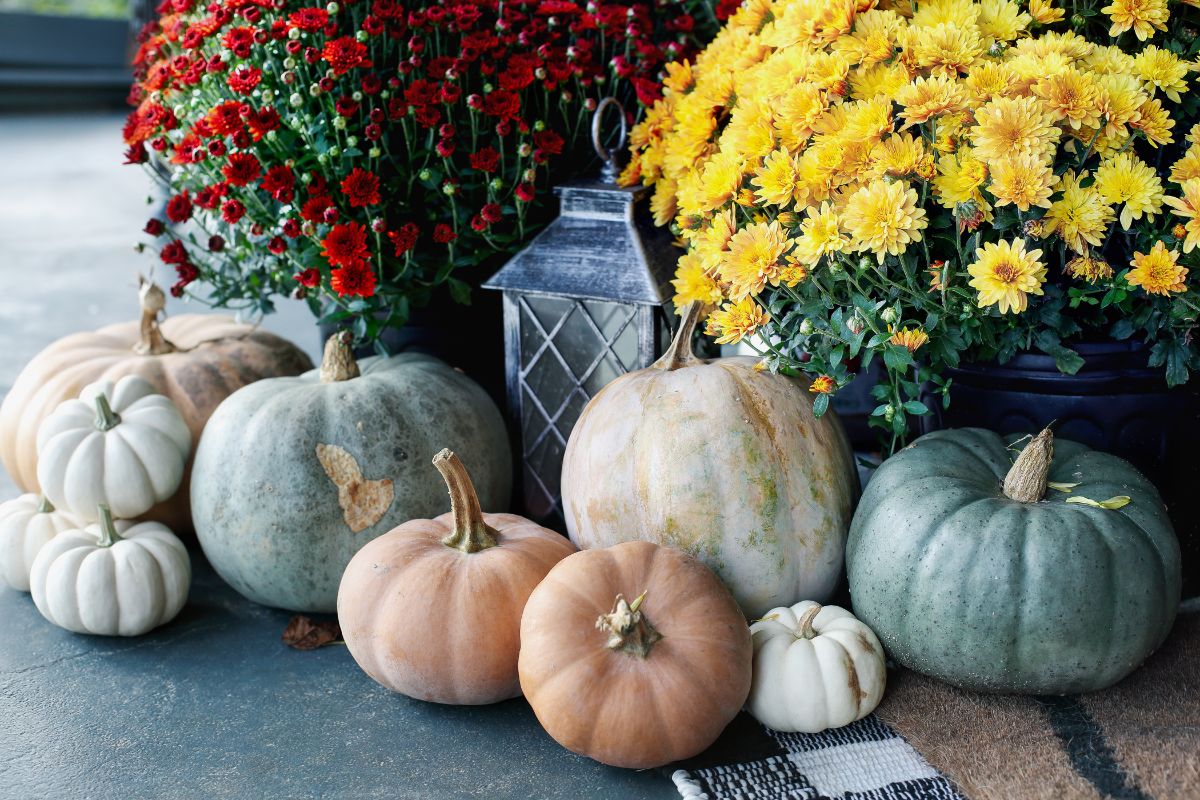
Filling porch planters with the golden yellows and crimson reds of fall is a great way to improve your home’s curb appeal and add extra color to your landscape. Plus, flower planters make the perfect backdrop for displaying your ornamental gourds and other fall décor. However, if you’re struggling to find the right plants for autumn planters, this guide is packed with the best cool-weather ornamentals for the end of the season!
Jump to:
- 20 best fall flowers and plants to grow in autumn container gardens
- 1. Mums (Chrysanthemums spp.)
- 2. Crotons (Codiaeum variegatum)
- 3. Asters (Aster spp.)
- 4. Sedum (Sedum spp.)
- 5. Marigolds (Tagetes spp.)
- 6. Ornamental peppers (Capsicum annuum)
- 7. Black-eyed Susan (Rudbeckia hirta)
- 8. Ornamental cabbage and kale (Brassica oleracea)
- 9. Pansies (Viola tricolor)
- 10. Petunias (Petunia spp.)
- 11. Helenium (Helenium autumnale)
- 12. Coneflowers (Echinacea spp.)
- 13. Coral bells (Heuchera spp.)
- 14. Coleus (Plectranthus scutellarioides)
- 15. Celosia (Celosia spp.)
- 16. Globe amaranth (Gomphrena globosa)
- 17. Zinnias (Zinnia spp.)
- 18. Purple fountain grass (Pennisetum setaceum rubrum)
- 19. Million bells (Calibrachoa spp.)
- 20. Cosmos (Cosmos bipinnatus)
- Summary
20 best fall flowers and plants to grow in autumn container gardens

When selecting fall flowers and foliage plants for container gardens, look for plants that have a good deal of cold hardiness so they won’t be troubled by fall frosts. Plants with flashy leaves in reds, oranges, yellows, and purples are also top choices for fall planters since they’ll coordinate with autumn foliage and Halloween décor too! Below you’ll find a selection of brilliant autumn container plants, which can be planted on their own or grown together for extra color and interest.
1. Mums (Chrysanthemums spp.)
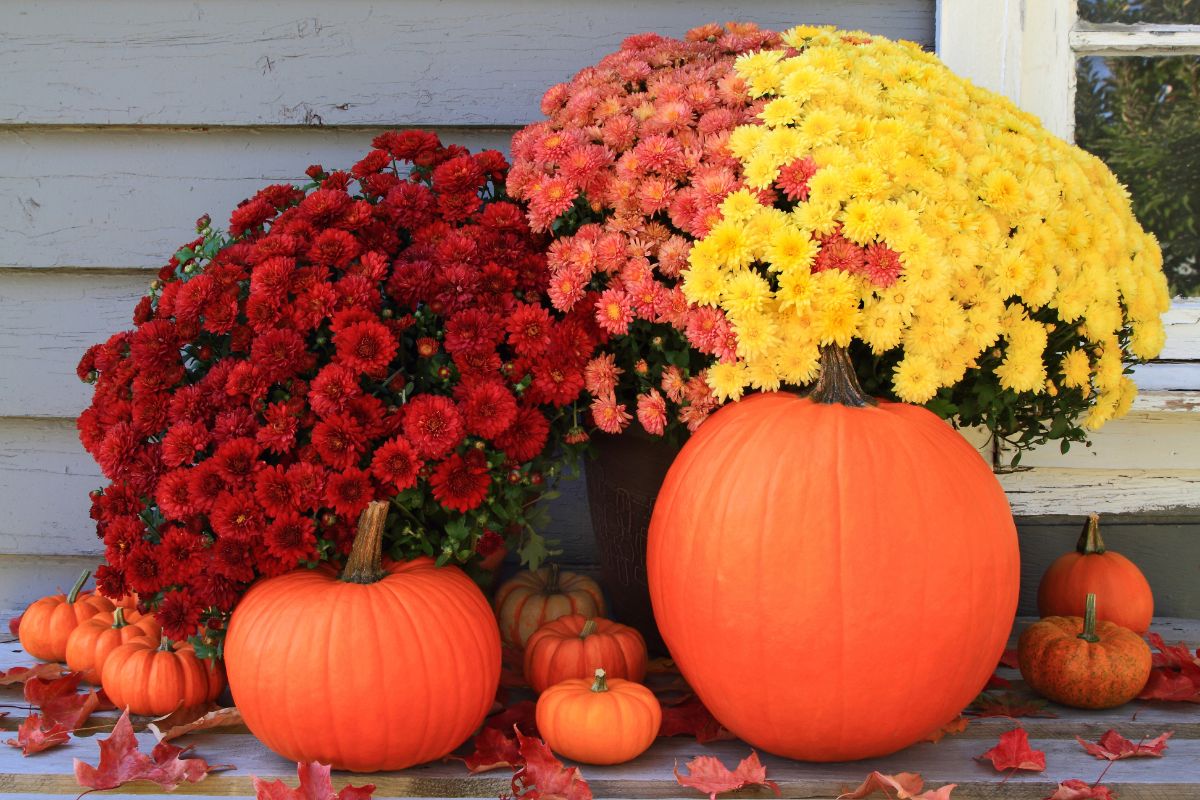
| Plant name: | Mums |
| Light requirements: | Bright light |
| Water requirements: | Moderate |
| Growing zone: | Zones 5 to 9 |
| Primary colors? | Orange, red, yellow, white, pink, green, purple |
Pretty as a picture, mums are one of the most classic choices for autumn container gardens. Not only are mums easy to keep in pots, but their flowers come in a range of traditional fall colors, including purple, orange, red, and yellow. For an eye-catching display, try growing a few different mum colors together or combine them with other autumn statement plants like crotons or ornamental grasses.
Mums can handle a light frost, but they aren’t very cold tolerant, so you may want to move your mums indoors when a hard frost is on the forecast. Alternatively, you can also cover mums up with a lightweight sheet or plant cover to protect them against the cold and keep them blooming longer. Frequent deadheading can keep your mums looking fresh and encourage them to produce more flowers.
2. Crotons (Codiaeum variegatum)
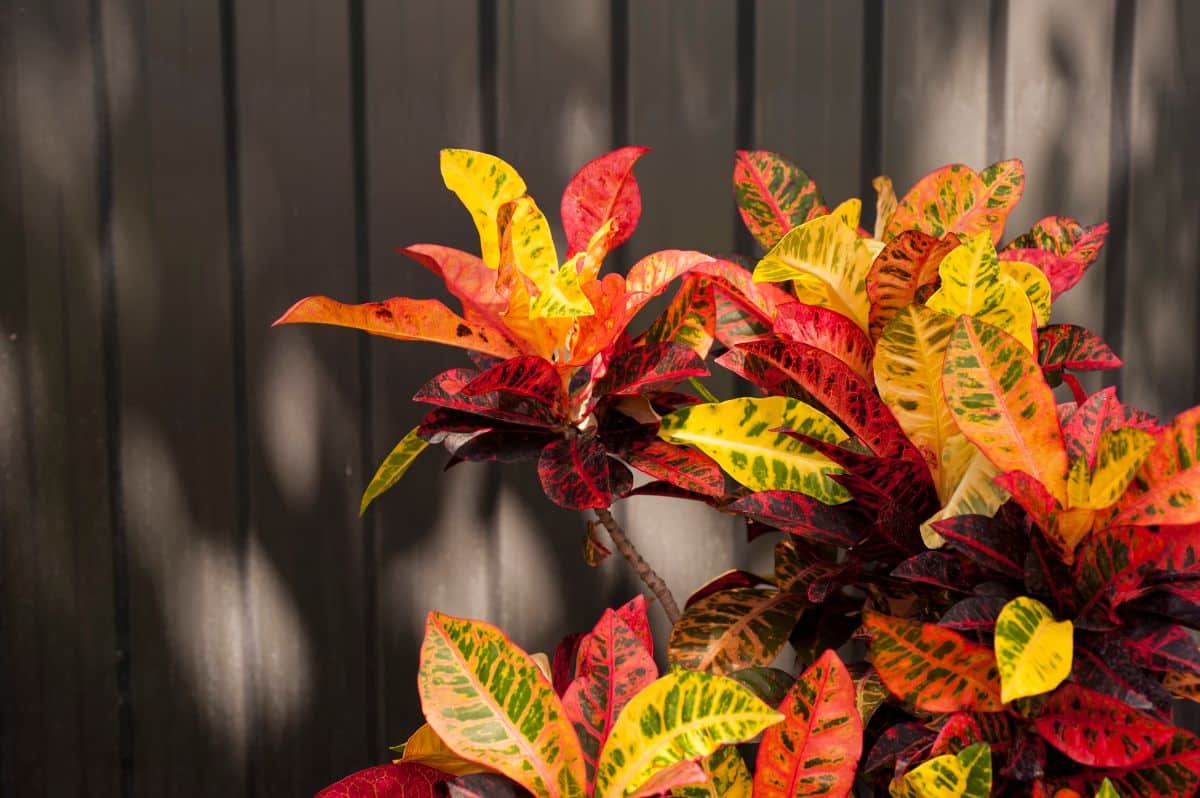
| Plant name: | Crotons |
| Light requirements: | Bright light to part shade |
| Water requirements: | Moderate |
| Growing zone: | Zones 9 to 11 |
| Primary colors? | Green, orange, yellow, red, pink, purple |
Crotons are most often grown as houseplants, but their easygoing nature also makes them top picks for outdoor container gardens. Crotons are mostly prized for their leaves, which come in a medley of exuberant reds, yellows, greens, and oranges. Planted in a container garden, crotons are sure to stand out, and they form a colorful backdrop for other ornamentals like mums and celosia.
There are over 100 different croton varieties to choose from, including plants with broad leaves and cultivars with leaves in curious, curled shapes and other whimsical forms. Some of the most popular types of crotons for outdoor arrangements are varieties like ‘Petra,’ ‘Gold Star,’ and ‘Zanzibar,’ although you can often find other croton types at local plant nurseries. Crotons can handle some cool weather, but cold snaps will damage their leaves, so you may want to move your crotons indoors and keep them as houseplants when the temperatures drop.
3. Asters (Aster spp.)
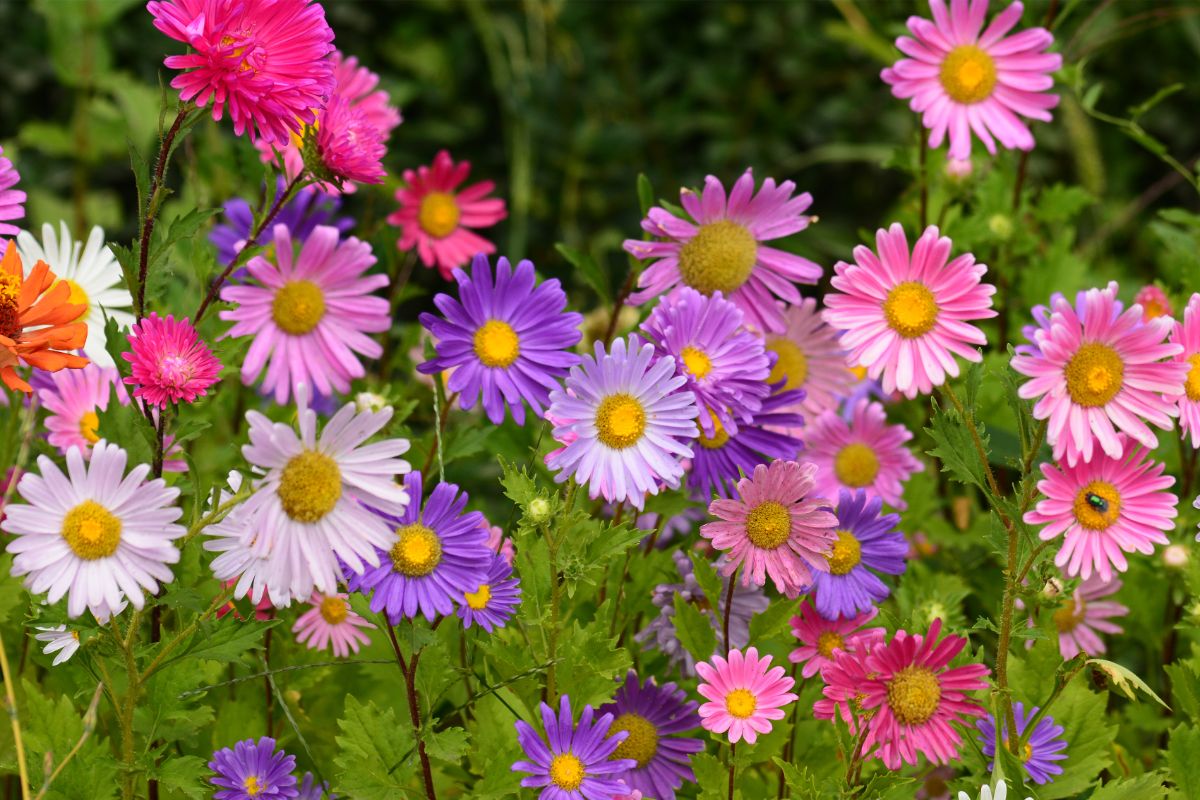
| Plant name: | Asters |
| Light requirements: | Bright light |
| Water requirements: | Moderate |
| Growing zone: | Zones 3 to 8 |
| Primary colors? | Purple, pink, white, blue |
A quintessential autumn flower, asters are often grown in inground flower beds, but their compact size also makes them suitable for container gardening. Asters are known for their darling, daisy-like blooms that come in various shades of purple, pink, white, and blue, and they look particularly attractive when paired with the golden tones of plants like marigolds. Beyond their beauty, asters are also rich in pollen and nectar, which provides an important food source for pollinators late in the season.
Unlike many other container plants, asters are perennials, so they’ll come back year after year if you let them. To help your asters overwinter in pots, you may want to add a bit of extra protection around your flower planters, or you can move your pots into a sheltered outbuilding or garage during the winter months. There are over 170 different species of asters, and some of the shorter varieties are the perfect size for growing toward the front of autumn containers.
4. Sedum (Sedum spp.)
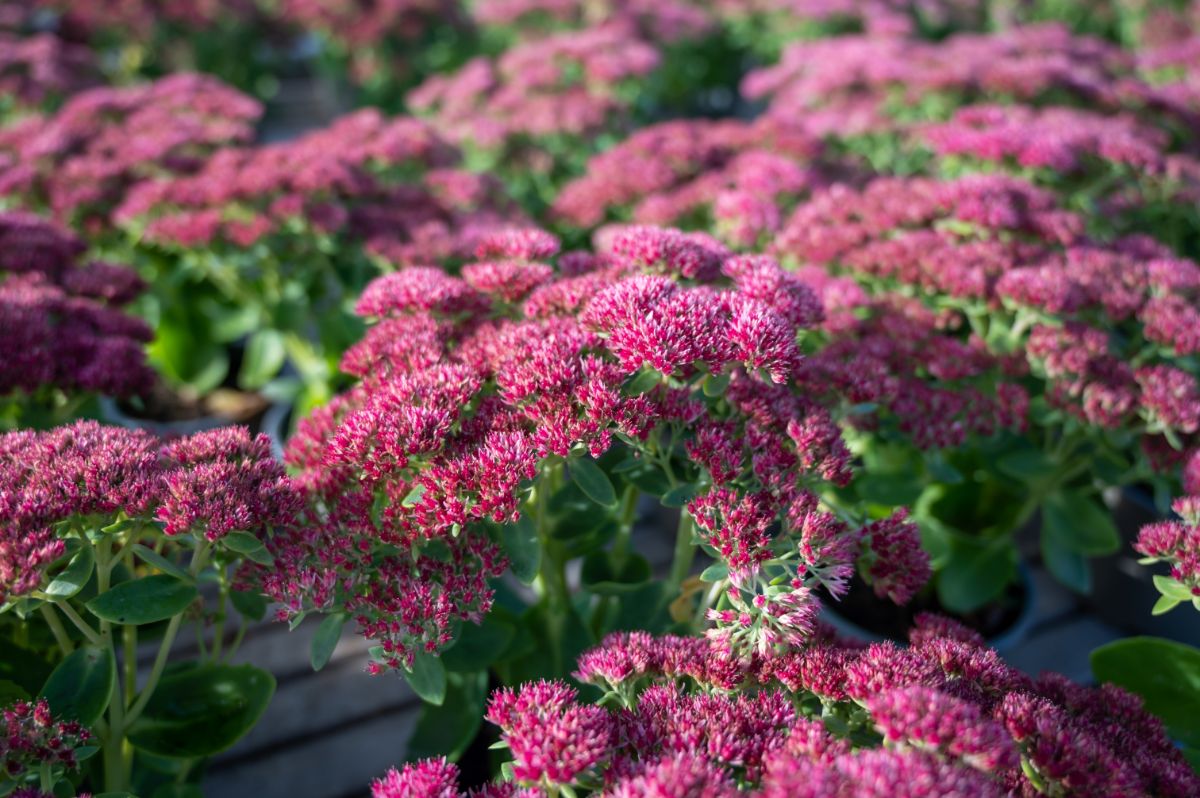
| Plant name: | Sedum |
| Light requirements: | Bright light |
| Water requirements: | Low |
| Growing zone: | Zones 3 to 11 |
| Primary colors? | Pink, yellow, bronze, white |
Sedum or stonecrop is another fall favorite that blooms late in the season, long after most other flowers have faded. This hardy plant has a good deal of cold tolerance, and sedums can continue to flower even after frosts. In fact, after flowering, sedum blooms often remain intact throughout the winter, providing extra interest to your container garden even when there’s snow on the ground.
One of the great things about sedum plants is that they are generally drought resistant, and they don’t need much water. If you’re someone who often forgets to water your planters, keeping sedum can be a wise choice since these plants will grow just fine even when their soil gets a bit dry. There are somewhere between 400 and 500 different species of sedum to choose from, including varieties that grow as ground covers, but ‘Autumn Joy’ is one of the most popular picks for autumn arrangements.
5. Marigolds (Tagetes spp.)
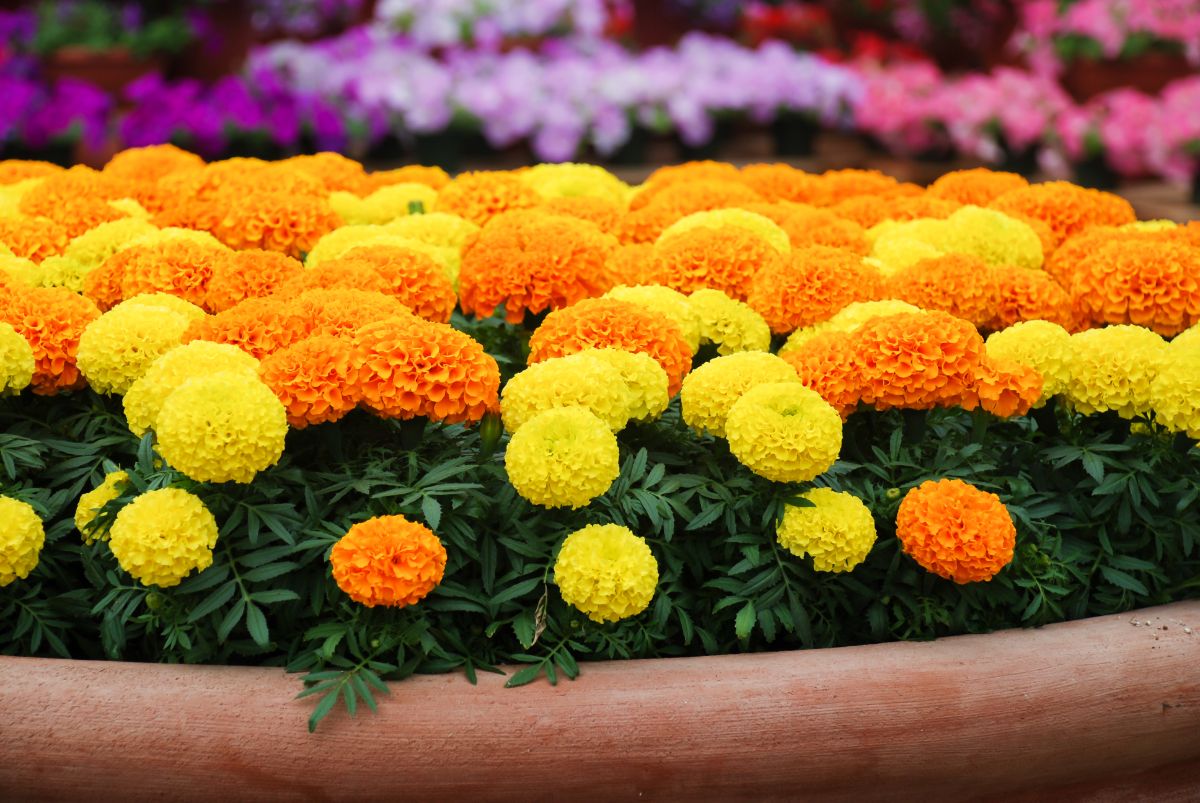
| Plant name: | Marigolds |
| Light requirements: | Bright light |
| Water requirements: | Moderate |
| Growing zone: | Zones 2 to 11 |
| Primary colors? | Yellow, orange, red, white |
Marigolds are often grown in vegetable gardens as companion plants to boost pollinator activity and repel noxious pests. However, marigolds can hold their own in ornamental displays, and their bright orange, red, copper, white, and yellow blooms are sure to draw the eye to your container garden.
Marigolds come in a range of sizes, including dwarf varieties that grow between 6 and 8” high and taller varieties that can stretch up to 3’ in height. Easy to grow and low maintenance, marigolds can be grown from nursery starts, or you can start your plants from seeds to save money on your gardening budget. Like mums, marigolds are not particularly frost tolerant, so be sure to enjoy your flowers before the temperatures get too cold!
6. Ornamental peppers (Capsicum annuum)
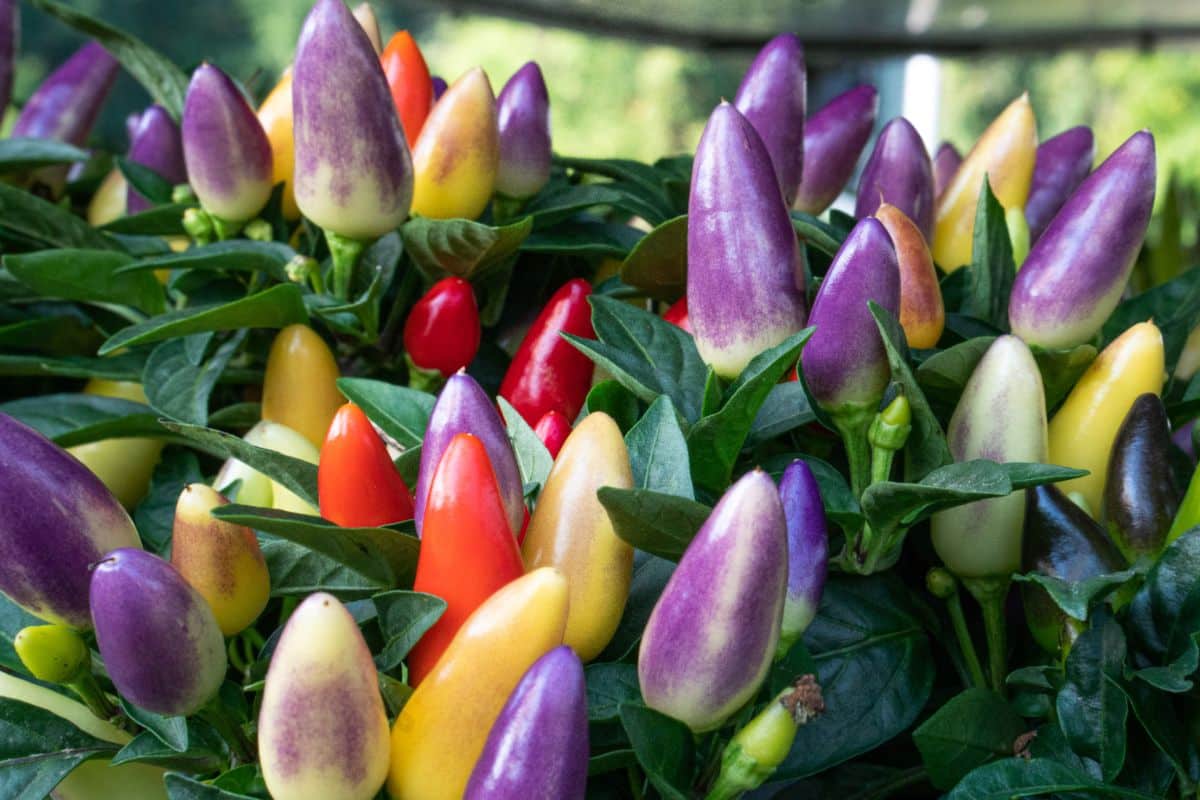
| Plant name: | Ornamental peppers |
| Light requirements: | Bright light |
| Water requirements: | Moderate |
| Growing zone: | Zones 9 to 11 |
| Primary colors? | Red, yellow, orange, purple, white, black |
Peppers are mostly thought of as edible plants, but peppers can be surprisingly attractive, and their bold coloration will coordinate beautifully with other autumn favorites like mums and crotons. You can grow many different types of peppers in ornamental arrangements, but some of the most popular choices are varieties like ‘Medusa,’ ‘Black Pearl’ and ‘Sangria.’ While ornamental peppers are technically edible, many of them are too spicy for most palates.
Peppers can handle some cooler weather and will continue to hold their color throughout early fall. However, when temperatures drop below freezing, the plants will die back, and their fruit will turn mushy. If you want to use your peppers for eating, harvest them early before a hard frost arrives.
7. Black-eyed Susan (Rudbeckia hirta)
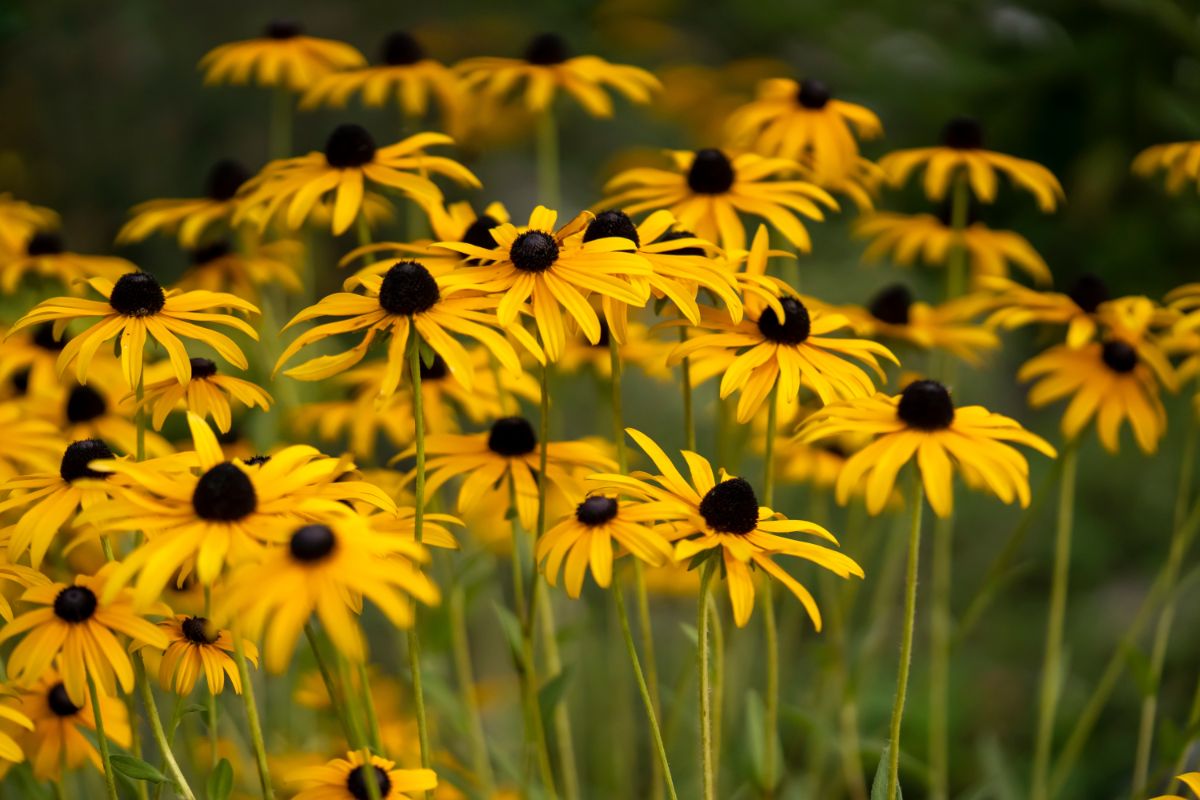
| Plant name: | Black-eyed Susan |
| Light requirements: | Bright light |
| Water requirements: | Moderate |
| Growing zone: | Zones 3 to 10 |
| Primary colors? | Yellow, bronze |
Black-eyed Susan are low-maintenance perennials that are native to North America. Another top choice for pollinators, black-eyed Susan is often grown in inground flower gardens, but these plants can also grow beautifully in pots where their slender stems will add height and movement. For extra vibrancy, try pairing black-eyed Susan with plants with purple coloration, like purple coneflower and purple mums.
Deadheading black-eyed Susans will extend their bloom time and encourage plants to produce more flowers. However, it can also be wise to leave old black-eyed Susan blooms in place as they will naturally self-sow and provide seeds for birds in winter. If you want to get even more use out of your black-eyed Susan, these plants also make fabulous cut flowers!
8. Ornamental cabbage and kale (Brassica oleracea)

| Plant name: | Ornamental cabbage and kale |
| Light requirements: | Bright light to part shade |
| Water requirements: | Moderate |
| Growing zone: | Zones 2 to 11 |
| Primary colors? | Green, red, purple, white, pink |
Cabbage and kale aren’t just edible plants! If you select ornamental varieties, these brassica plants have fantastic autumn color, and they’re super cold tolerant too. With frilly leaves that come in shades of cream, white, and a vivid purple, ornamental brassicas can rival any autumn flower, and they can survive even when temperatures drop to single digits!
With a bit of extra care and maintenance, you may be able to grow ornamental kale and cabbage throughout the winter months. So if you want to keep your container garden looking vibrant in winter, give these plants a try. When snow is expected, you can protect your cabbage and kale leaves by covering them with milk jugs, cardboard boxes, or cloches, which will keep the leaves from being crushed by the weight of the snow.
9. Pansies (Viola tricolor)

| Plant name: | Pansies |
| Light requirements: | Bright light |
| Water requirements: | Moderate |
| Growing zone: | Zones 6 to 10 |
| Primary colors? | Most colors |
Everybody’s favorite border flower, pansy blooms look a bit tiny, smiling faces with colorful petals in an assortment of shades. While pansies are commonly grown in inground gardens for extra color, their short stature and low maintenance needs also make them wonderful container plants. You can fill up your planters with a mix of pansy flowers or use pansies in conjunction with taller ornamentals like coneflowers and celosia.
Despite their delicate look, pansies can handle cold weather like champs, and they can even survive a light frost. But while pansies can continue to grow in cool temperatures, temperatures below 25°F will usually cause the plants to wilt. Beyond being adorable ornamental plants, pansies are also great for crafters since they make some of the best-pressed flowers!
10. Petunias (Petunia spp.)
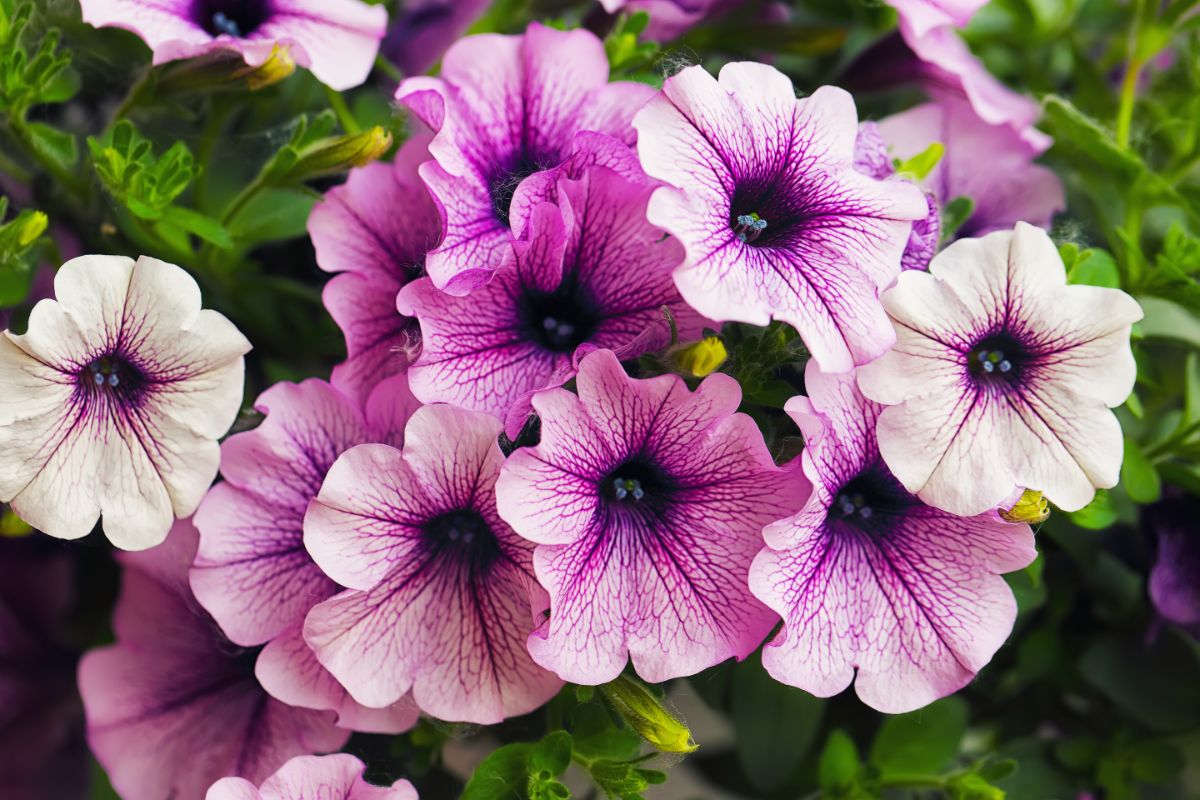
| Plant name: | Petunias |
| Light requirements: | Bright light |
| Water requirements: | Moderate |
| Growing zone: | Zones 9 to 11 |
| Primary colors? | Most colors |
Petunias are relatively tough plants that can continue to flower from spring through fall, although they aren’t quite as frost tolerant as pansies. Wave petunias, however, can continue to grow in cold weather, and they can handle temperatures as low as 35°F. Petunias are mostly known for their trumpet-shaped flowers that come in almost every color imaginable, including shades so dark they appear black in most lighting.
For autumn arrangements, petunias in golds, oranges, reds, yellows, and purples are popular picks, but you can also find bi-colored petunia blooms that are even more showy. Interestingly, petunias are actually members of the nightshade family, which also includes tomatoes and peppers. So, if you want to keep ornamental peppers in your autumn container garden, you can also grow petunias nearby, as these two plants have very similar care requirements.
11. Helenium (Helenium autumnale)

| Plant name: | Helenium |
| Light requirements: | Bright light |
| Water requirements: | Moderate |
| Growing zone: | Zones 3 to 8 |
| Primary colors? | Red, yellow, orange |
Also known as sneezeweed, helenium is a staple plant in cottage gardens, but it also fits right into wildflower arrangements and native plantings. Helenium plants are native to North America, and they begin to bloom in late summer to early fall, just in time for autumn container gardens. Even better, helenium blooms come in the classic autumn hues of gold, yellow, orange, and red.
If you are reluctant to grow helenium due to its nickname, “sneezeweed,” don’t worry about this plant causing allergies. Sneezeweed actually got its name because it used to be included in snuff blends, and according to folklore, it could drive away evil spirits. But in container gardeners, helenium is simply a pretty plant, and it grows beautifully beside other moisture-loving ornamentals like petunias.
12. Coneflowers (Echinacea spp.)

| Plant name: | Coneflowers |
| Light requirements: | Bright light |
| Water requirements: | Moderate |
| Growing zone: | Zones 3 to 9 |
| Primary colors? | Purple, pink, yellow, orange, white, red |
Coneflowers are another popular native plant, and they’re much prized in pollinator gardens thanks to their pollen-rich blooms. A prime food source for butterflies, bees, and other beneficial insects, coneflower seeds can also feed wild birds in autumn and winter if you don’t deadhead the flowers. When in bloom, coneflowers will brighten up your planters with their large, daisy-like flowers, and they are perfect partners for plants like black-eyed Susan and globe amaranth.
Most people are familiar with purple coneflowers, but coneflowers come in other colors too, including yellow, orange, pink, white, and red. Coneflowers grow about 2 to 5’ tall, so be sure to research how big your particular cultivars will grow before sowing them in your planters. Best of all, coneflowers grow as perennials in most areas, so you may be able to enjoy these plants for many years to come.
13. Coral bells (Heuchera spp.)
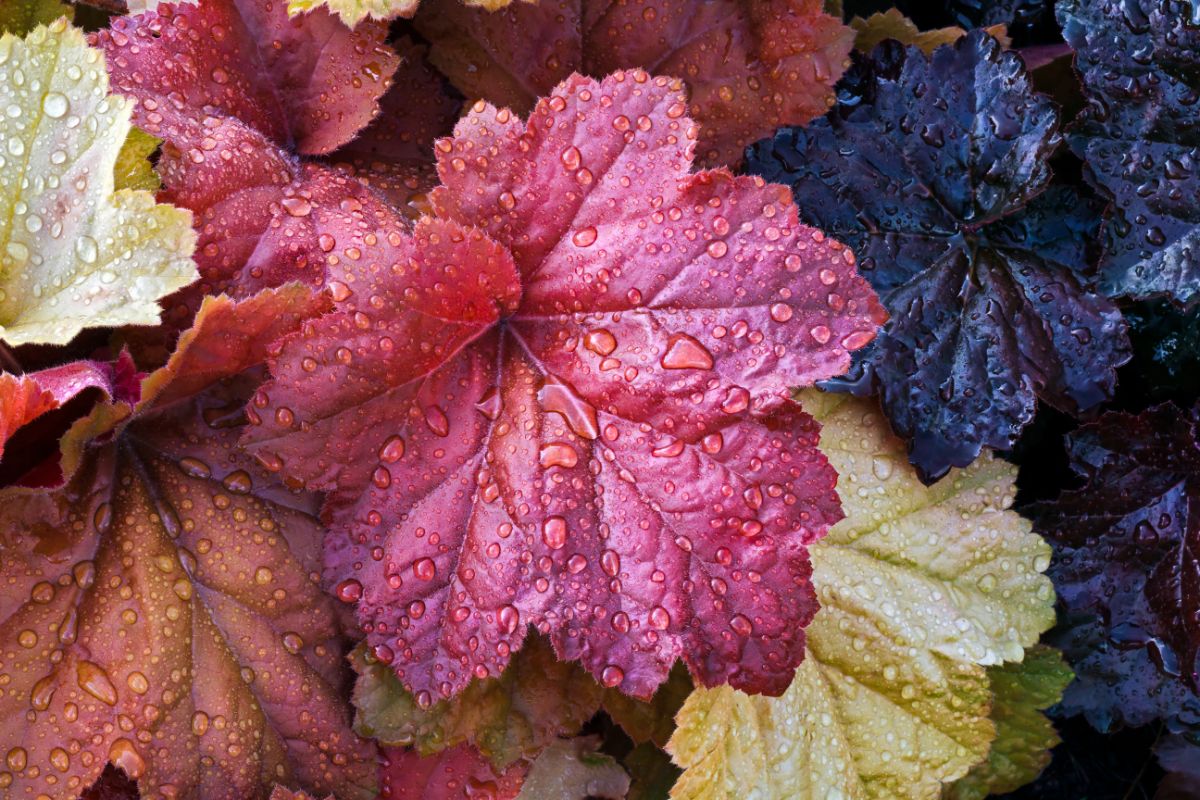
| Plant name: | Coral bells |
| Light requirements: | Full sun to part shade |
| Water requirements: | Moderate |
| Growing zone: | Zones 4 to 9 |
| Primary colors? | Green, yellow, pink, peach, purple |
Coral bells are mostly grown for their ornamental leaves, which come in an assortment of tones like chartreuse, gold, purple, maroon, and peach. Planted en masse, coral bells’ bright coloration can cause a sensation in any garden, but these plants are lively enough to hold your attention in container gardens too. And while coral bells can also produce airy flower sprays, they bloom around mid-summer, so they’re primarily kept for their colorful leaves in autumn gardens.
Since coral bells prefer part shade, these plants will be content in planters kept under a covered porch or on a shady patio. Coral bell plants range in height from about 6 to 16” tall, but they tend to spread out horizontally, which makes them good choices for filling in empty spaces in your arrangement. Plus, coral bells also happen to be resistant to rabbits and deer!
14. Coleus (Plectranthus scutellarioides)
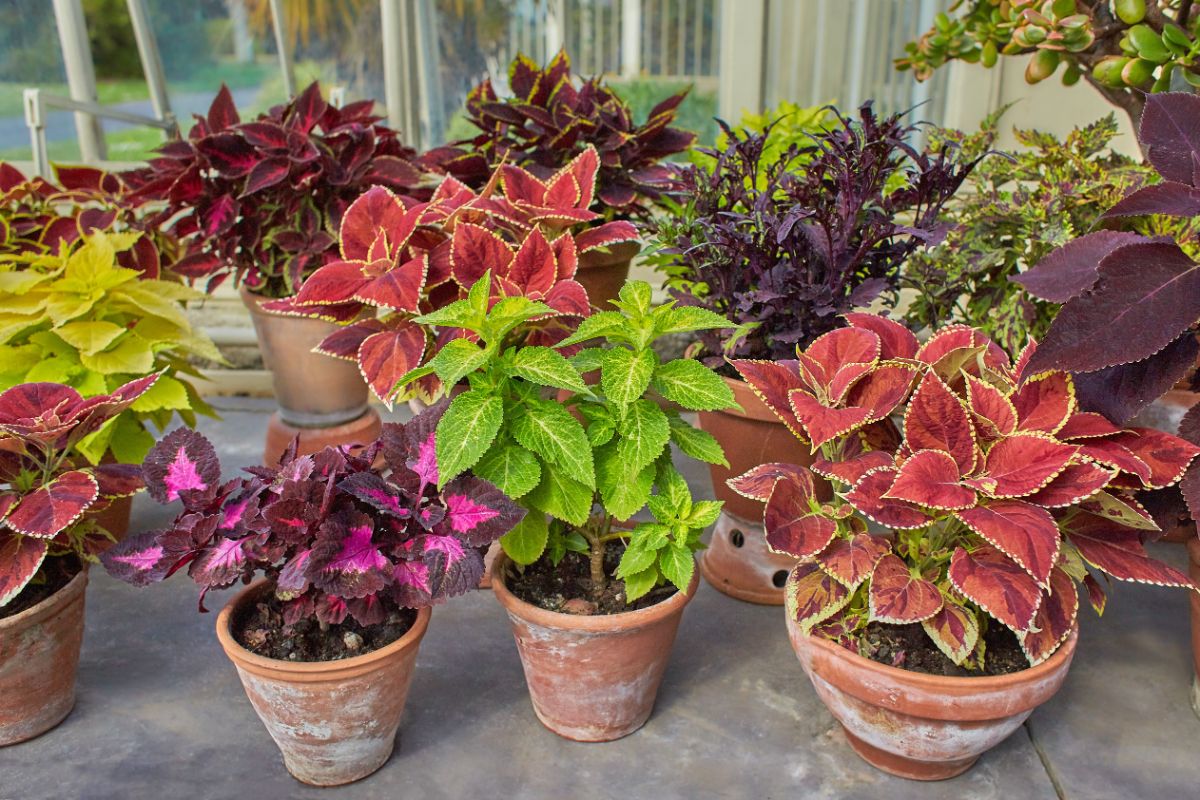
| Plant name: | Coleus |
| Light requirements: | Part shade |
| Water requirements: | Moderate |
| Growing zone: | Zones 10 to 11 |
| Primary colors? | Purple, red, pink, yellow, orange, green |
Like coral bells, coleus are popular foliage plants with leaves that come in bright shades of green, red, purple, and more. Some people grow coleus as houseplants, but their high humidity needs can make them somewhat difficult to care for indoors. However, these plants are quite easygoing in container gardens, and they can provide color to your arrangement throughout the changing seasons.
Coleus plants range in size from 6” to over 3’ tall, and while most coleus plants maintain an upright growth habit, some coleus also have trailing stems that can be used as a spiller element in planters. Try out coleus with other autumn ornamentals like mums for a lively container display that’s certain to impress the neighbors and garden visitors too!
15. Celosia (Celosia spp.)

| Plant name: | Celosia |
| Light requirements: | Bright light |
| Water requirements: | Moderate |
| Growing zone: | Zones 2 to 11 |
| Primary colors? | Red, yellow, orange, pink, purple, white |
Celosia plants produce bursts of uniquely formed flowers in shades of red, yellow, orange, and pink, and their colors blend right in with other fall flowers. There are a number of different celosia varieties on the market today, but ‘Cock’s Comb,’ ‘Plumed,’ and ‘Crested’ celosias are some of the most popular. Celosia flowers are slightly reminiscent of wheat, and they look particularly attractive when paired with other strong silhouettes, like purple fountain grass.
Celosia are annuals in most areas, although they can grow perennially in zones 10 through 12. These plants are super easy to sprout from seed, but you can also grow them from nursery starts. Locate celosias towards the front of your planters so you can view their flowers in all their autumnal glory!
16. Globe amaranth (Gomphrena globosa)
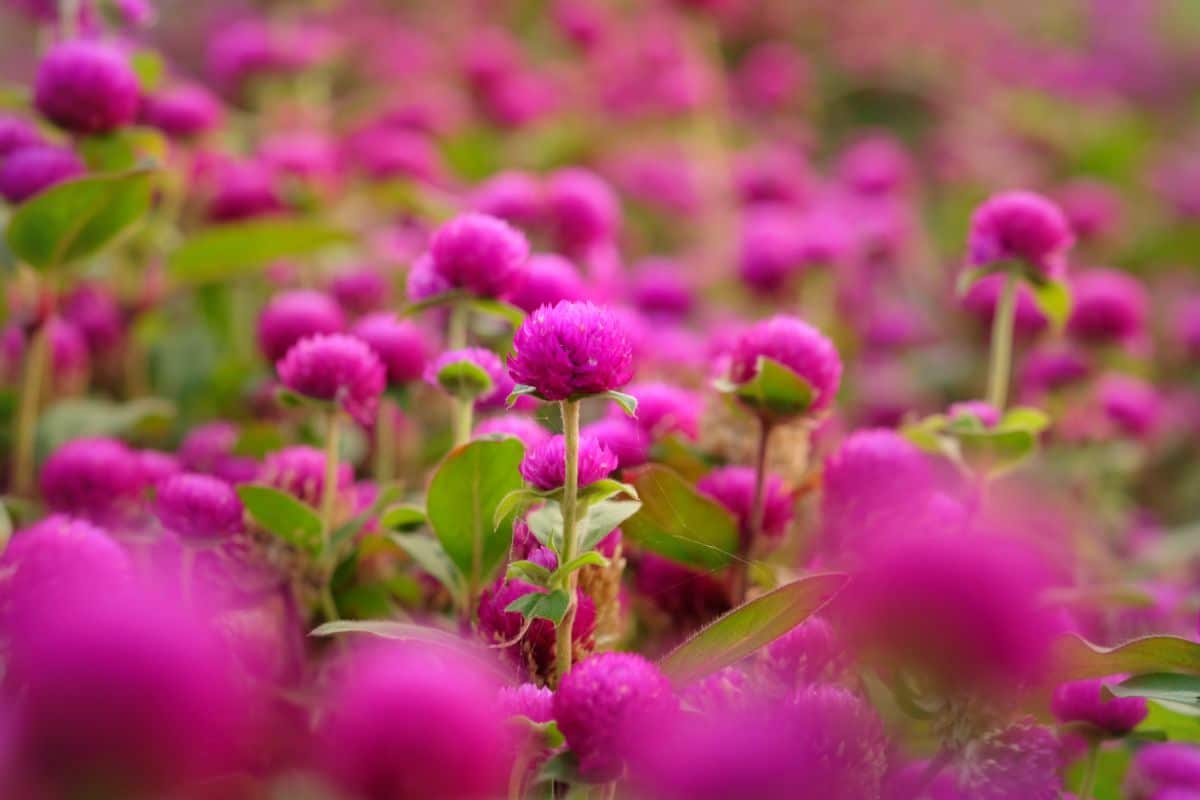
| Plant name: | Globe amaranth |
| Light requirements: | Bright light to part shade |
| Water requirements: | Moderate |
| Growing zone: | Zones 2 to 11 |
| Primary colors? | Red, orange, pink, white, purple |
Many different amaranth varieties can be spectacular additions to autumn gardens, but the globe amaranth is a particularly good choice for container planters. Unlike other amaranth species, globe amaranth has a shorter growth habit, and it only grows between 1 and 4’ tall. However, this plant has all of the colors of other amaranth cultivars, and it’s particularly noteworthy for its small, globe-shaped flowers.
Although globe amaranth will grow best in sunny planters, it can handle some shade. That said, globe amaranth plants will still need plenty of light throughout the day as low light conditions can cause the plant to stretch and become leggy. Pair globe amaranth with other textural plants like purple fountain grass, or grow it with other bright beauties like coral bells and celosia for an unforgettable planter arrangement.
17. Zinnias (Zinnia spp.)

| Plant name: | Zinnias |
| Light requirements: | Bright light |
| Water requirements: | Moderate |
| Growing zone: | Zones 2 to 11 |
| Primary colors? | Green, yellow, orange, white, pink, red, purple |
Zinnias are long-season flowers that can bloom from spring through fall, and they make long-lasting cut flowers too. But while the bright colors of zinnia blooms look right at home in autumn planters, these heat-loving flowers don’t handle cold well, and they won’t survive a frost.
Covering up your planters before cold weather or moving your planter into a sheltered location can extend the life of your zinnias. Alternatively, if you want to keep your planters looking full later into the season, you may want to grow zinnias with more cold hardy plants that can take over after your zinnia flowers fade.
18. Purple fountain grass (Pennisetum setaceum rubrum)
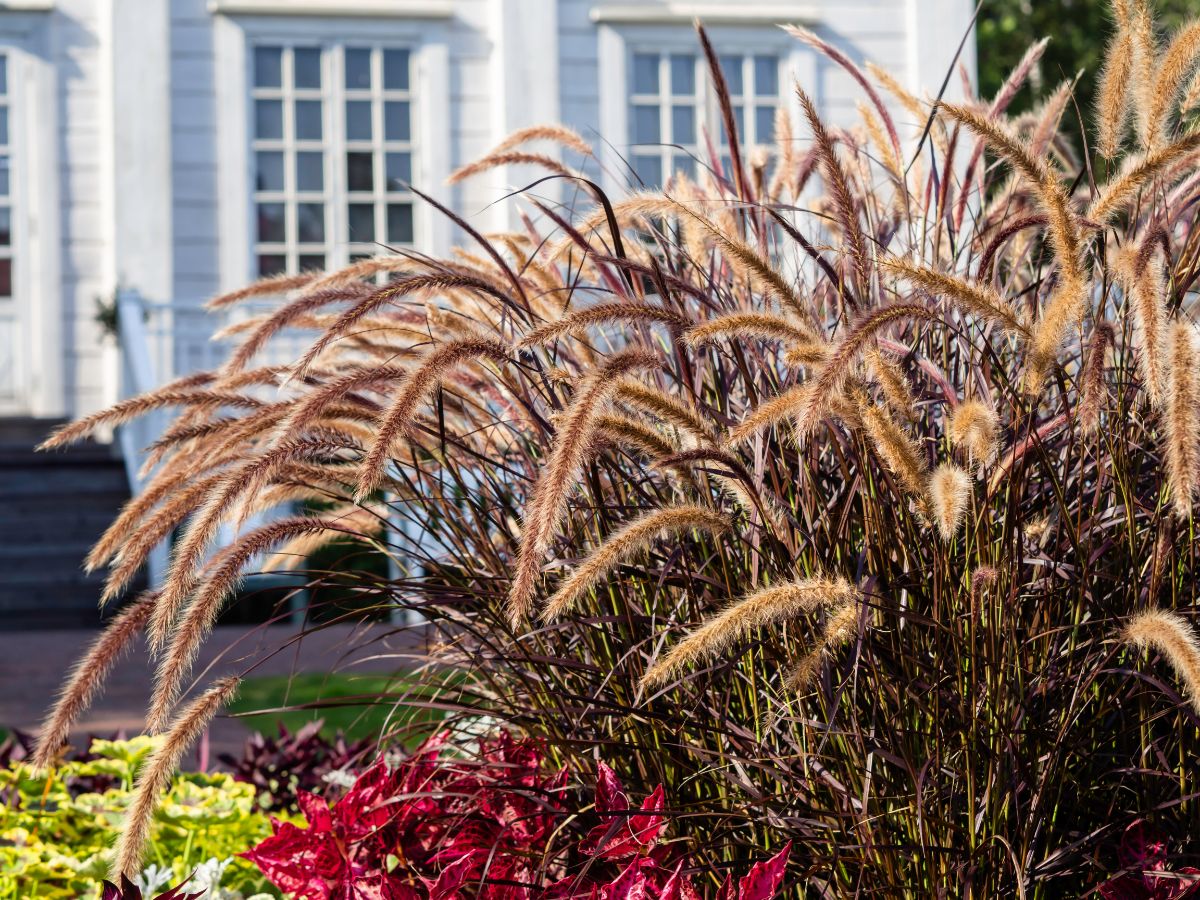
| Plant name: | Purple fountain grass |
| Light requirements: | Bright light |
| Water requirements: | Moderate |
| Growing zone: | Zones 9 to 10 |
| Primary colors? | Purple, cream |
Purple fountain grass is a larger plant that can grow up to 5’ tall, so it may not fit in all container gardens. But if your planter is large enough to accommodate this ornamental grass, you won’t be disappointed. Aside from its deep, dark coloration, purple fountain grass adds an interesting texture to floral designs, and its delicate grass heads will add movement when the wind blows.
Despite the fact that purple fountain grass only grows as a perennial in zones 9 and 10, this plant can handle cold weather, and it will bounce back after frosts. Purple fountain grass makes a solid backdrop to other lower-growing ornamentals, but it can also be used to draw attention to seasonal autumn décor, like decorative scarecrows, pumpkins, and ornamental corn.
19. Million bells (Calibrachoa spp.)
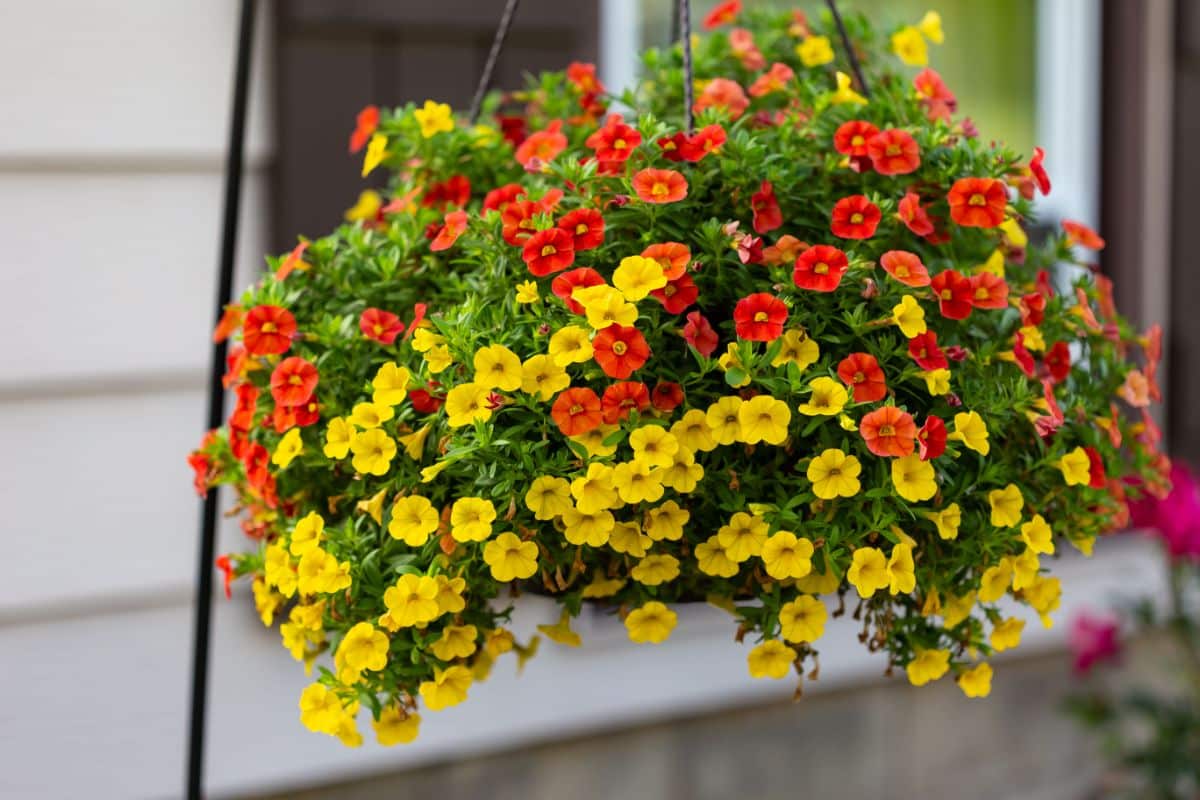
| Plant name: | Million bells |
| Light requirements: | Bright light to part shade |
| Water requirements: | Moderate |
| Growing zone: | Zones 9 to 11 |
| Primary colors? | Most colors |
Million bells look like tiny petunias with trumpet-shaped flowers that come in almost every color imaginable. These beginner-friendly plants have a cascading growth habit that looks striking when allowed to trail naturally over pot margins. These plants also work well in hanging baskets, and they can handle a light frost too.
20. Cosmos (Cosmos bipinnatus)
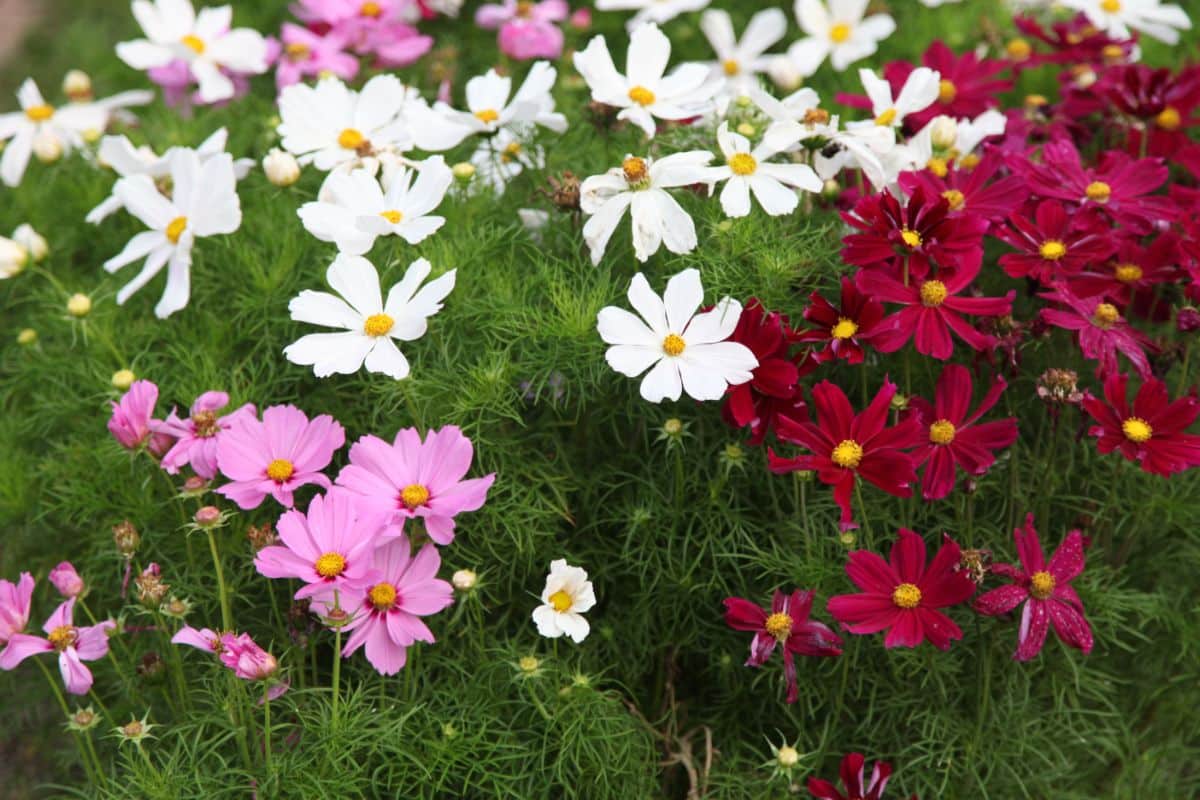
| Plant name: | Cosmos |
| Light requirements: | Bright light |
| Water requirements: | Moderate |
| Growing zone: | Zones 2 to 11 |
| Primary colors? | Red, pink, yellow, orange, white |
Cosmos aren’t often thought of as autumn flowers, but they can handle light frosts with ease, and they’ll add something unexpected to your autumn planters. Cosmos blooms come in various shades of pink and white, and their feathery leaves will add grace and movement to container gardens. If you prefer a cottage garden aesthetic, you may want to try cosmos out with other bright flowers, like globe amaranth, coneflowers, and black-eyed Susans.
Summary
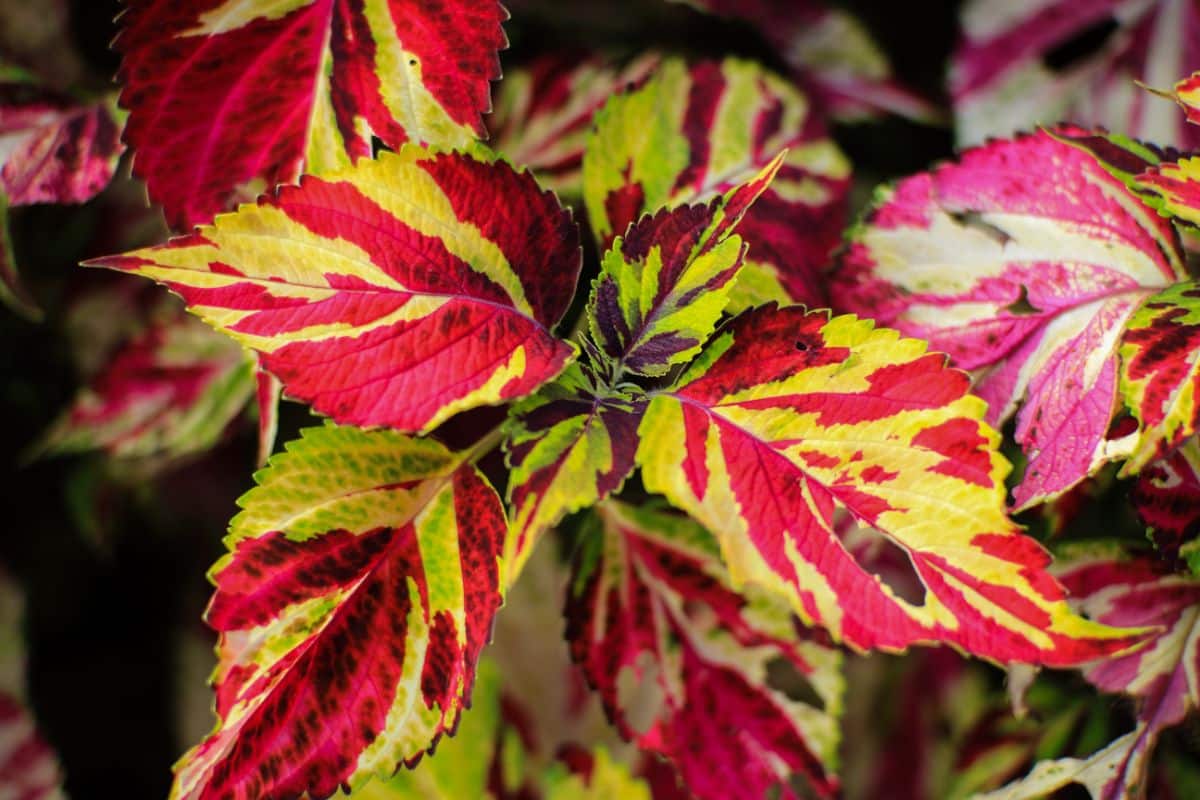
After the long summer season, gardens can look a bit dull in autumn. But with the right foliage and flowering plants in your container gardens, you can bring color back into your landscape and extend your gardening time well into autumn. With a bit of creativity and the cold hardy plants we’ve covered today, your patio and porch planters are sure to be the envy of the neighborhood, and they’re a perfect way to celebrate the fall season too!
As pretty as autumn container gardens can be, if you prefer to grow plants in inground beds, there are plenty of fall flowers that will thrive in ornamental gardens as well. Check out this guide for our favorite large flowers and foliage plants for late-season color.

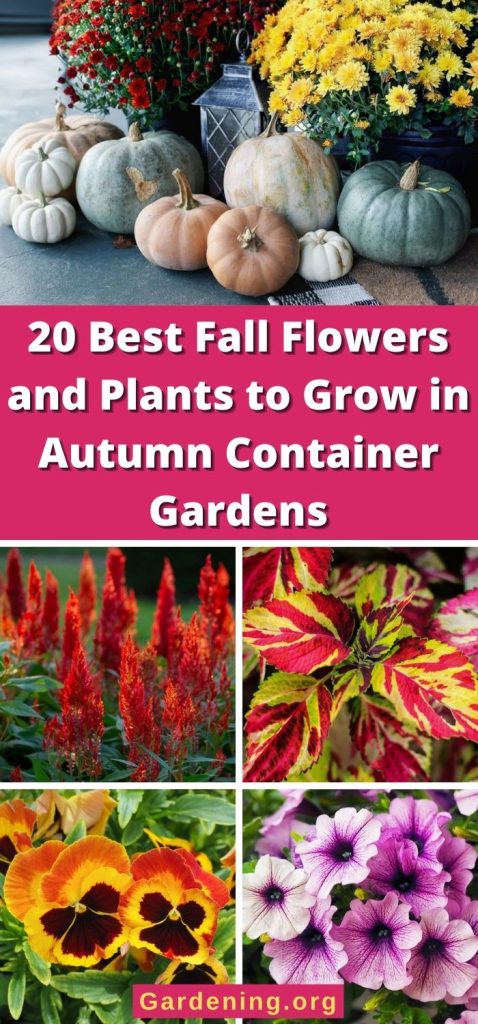
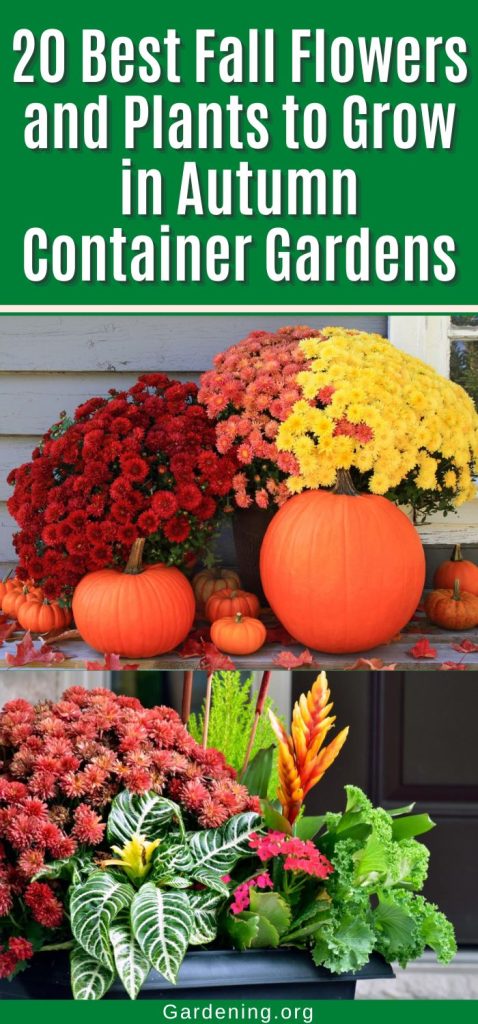

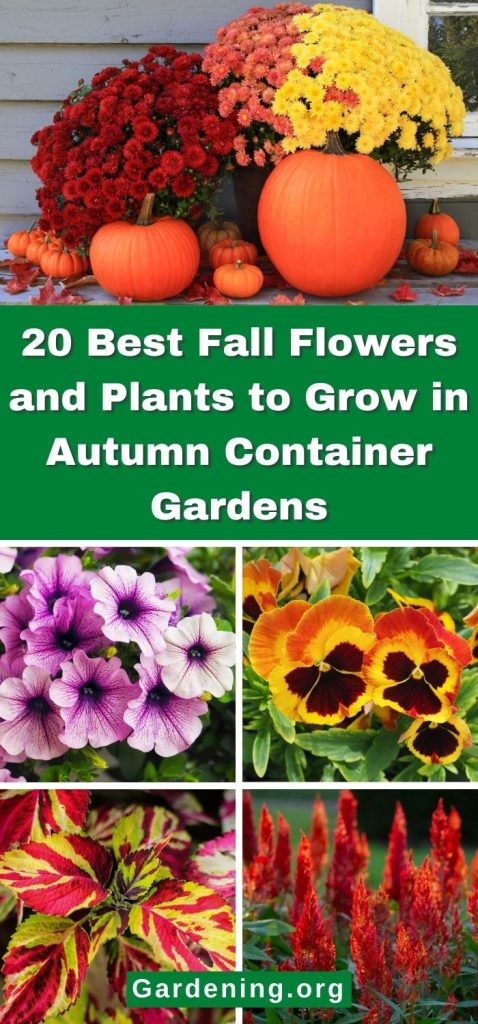

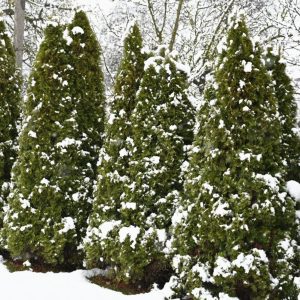


Mary.Coakley
This list of Autumn flowers are just what I need.I love getting your emails so much natural information